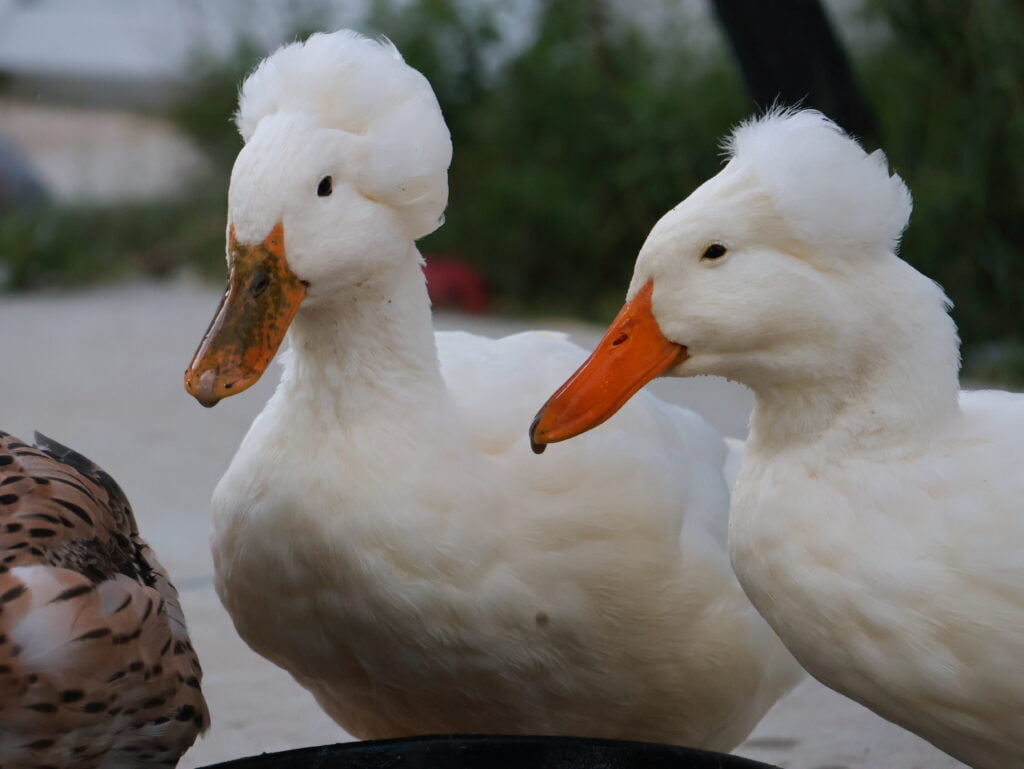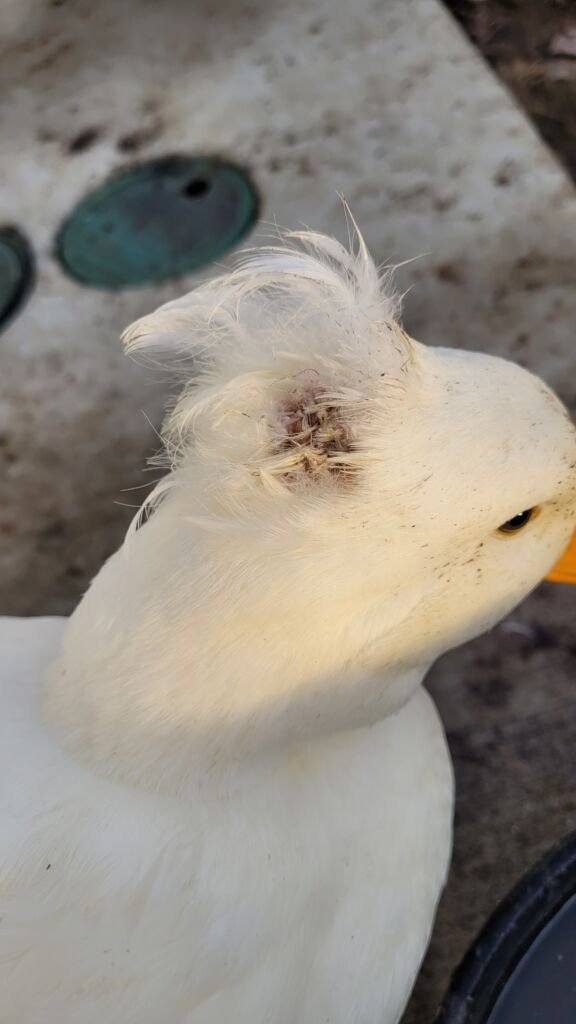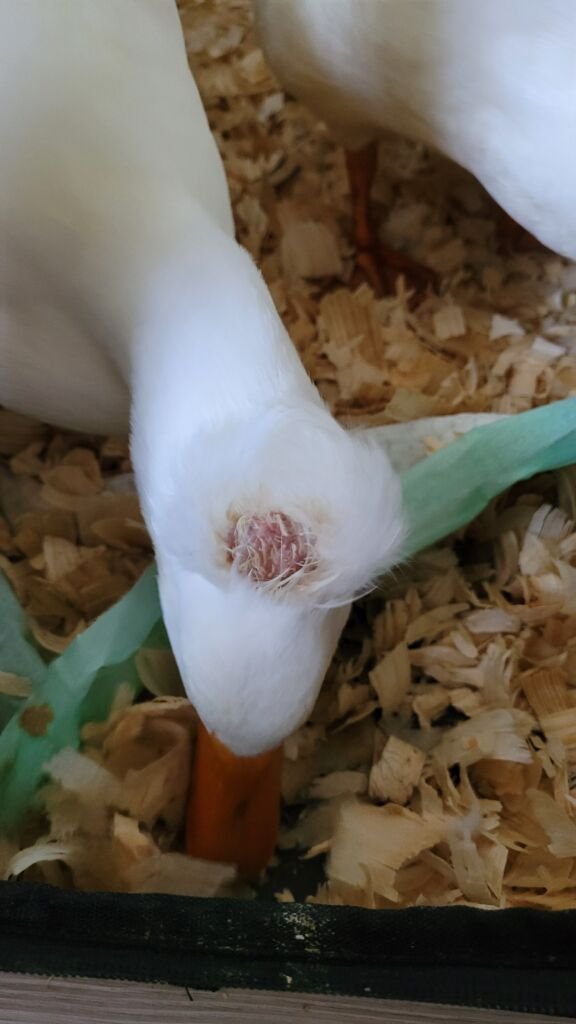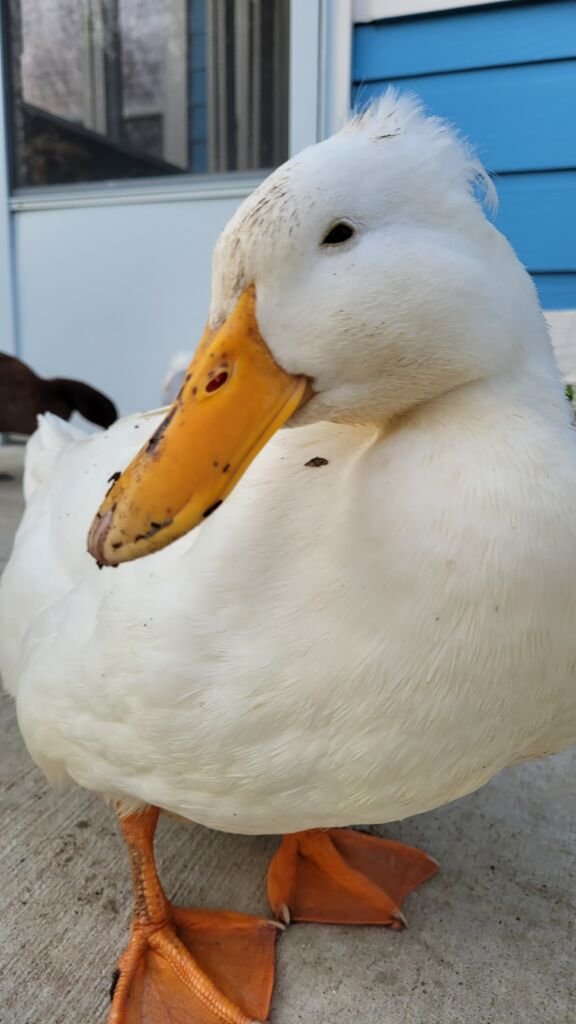Last updated on June 18th, 2024 at 07:08 pm
Crested ducks are undeniably adorable with their charming crests and friendly personalities. However, behind their cute appearance lies a genetic anomaly that potential owners should be aware of before welcoming them into their homes.
When we started with our small flock, we wanted crested ducks because they are so adorable and cute. Little did we know about their genetic defect. I wish I did my research before getting them. While Schnatterinchen is doing just fine, Emma has some neurological problems. She had seizures when she was a duckling. You can imagine how scared I was. This is why I am writing this log.
I want you to be aware of their potential health issues before getting them. Or ideally, completely refrain from getting crested ducks.

The Genetic Mutation
- The defining feature of crested ducks is their distinctive crest, which is the result of a genetic mutation. While this mutation adds to their appeal, it’s important to understand its implications.
- The same gene responsible for the crest can also lead to other issues, including skull deformities and neurological problems. These conditions may affect the duck’s health and quality of life.
- Many crested ducks often become special needs animals, needing significant care and attention.
Understanding the Genetic Defect
The crested appearance of these ducks is caused by a genetic mutation known as “crested gene” or “cresting gene.” This gene disrupts the normal development of the skull during embryonic growth, resulting in the characteristic feathered crest atop the duck’s head. While visually striking, this mutation can also lead to various health concerns. In some cases, the skull may not fully develop around the brain, leaving the duck more vulnerable to head injuries.
Additionally, the misplacement of feathers around the head can obstruct the duck’s vision, potentially leading to accidents or difficulty foraging for food. Furthermore, the same gene responsible for the crest can also be linked to neurological issues, such as seizures or imbalance, which can affect the duck’s overall well-being. Understanding these genetic factors is essential for responsible ownership and ensuring the health and welfare of crested ducks in captivity.

Cranial Defects and Fatty Tissue
The genetic mutation responsible for the crested appearance in ducks can sometimes lead to cranial defects, including a condition known as “open skull.” This defect occurs when the skull fails to fully close around the brain during development, leaving a gap or hole in the skull. This opening exposes the brain to potential injury, making crested ducks more susceptible to head trauma. Additionally, the misplacement of feathers around the head can exacerbate this vulnerability by offering limited protection.

Moreover, in some cases, crested ducks may develop abnormal fatty tissue deposits around the cranial region. These deposits can further obscure the underlying cranial structure and may contribute to the duck’s susceptibility to head injuries. While the exact mechanism behind the development of fatty tissue in crested ducks is not fully understood, it is believed to be related to the same genetic factors responsible for the crest formation.

Understanding these cranial defects and fatty tissue issues is crucial for crested duck owners, as it underscores the importance of providing a safe and secure environment to minimize the risk of head injuries. Additionally, regular veterinary check-ups can help monitor the duck’s overall health and address any potential issues early on. By being aware of these genetic predispositions, owners can take proactive measures to ensure the well-being of their crested ducks and provide them with the best possible care.
Health Concerns Associated with Crested Ducks
Crested ducks are more susceptible to head injuries due to their prominent crests. The feathers can obscure their vision, making them more prone to accidents, especially in outdoor environments with potential hazards.
Mating can be a vulnerable time for crested ducks, particularly because the drake grasps onto their crest feathers. This behavior can result in feather pulling and, more importantly, potentially lead to head injuries.

Additionally, some crested ducks may experience neurological issues associated with the genetic mutation. These can manifest as balance problems, seizures, or other neurological abnormalities.
Skull Deformities:
- The genetic mutation responsible for the crested appearance can sometimes result in skull deformities, including an open skull or cranial gap. This condition leaves the brain more vulnerable to injury due to the lack of protection from the surrounding bone structure.
- Skull deformities can lead to increased susceptibility to head trauma, which may occur during normal activities such as foraging, mating, or navigating their environment.
- Owners should be vigilant for signs of head injuries, such as bleeding, swelling, or changes in behavior, and seek veterinary care promptly if any concerns arise.
Vision Impairment:
- The crest of feathers on the duck’s head can sometimes obstruct their vision, limiting their ability to see clearly.
- Reduced visibility may increase the risk of accidents or injuries, as crested ducks may have difficulty navigating their surroundings, avoiding obstacles, or detecting predators.
- Owners should provide a safe and well-defined environment for their crested ducks, minimizing potential hazards and obstacles that could pose a risk to their safety.

Neurological Issues:
- Some crested ducks may experience neurological issues associated with the genetic mutation responsible for the crest.
- These issues can manifest as seizures, tremors, imbalance, or other neurological abnormalities.
- Neurological symptoms may vary in severity and frequency, and affected ducks may require ongoing management and veterinary care to maintain their quality of life.
Feather and Skin Health:
- The feathers on the crest of crested ducks require regular grooming to prevent matting and maintain cleanliness.
- Feather mats can become breeding grounds for bacteria or parasites, leading to skin infections or discomfort for the duck.
- Owners should monitor the condition of their duck’s crest regularly and gently comb out any tangles or mats to promote healthy feathers and skin.

Respiratory Health:
- Crested ducks may be more prone to respiratory issues due to the crests obstructing their nasal passages or affecting their ability to preen effectively.
- Blocked nasal passages can make breathing more difficult and may increase the risk of respiratory infections or inflammation.
- Owners should provide adequate ventilation in their duck’s living environment and monitor for signs of respiratory distress, such as wheezing, coughing, or labored breathing.
Understanding these potential health concerns is essential for crested duck owners to provide proactive care and support for their feathered companions. Regular veterinary check-ups and attentive observation can help identify and address any issues early on, ensuring the best possible quality of life for crested ducks in captivity.

Responsible Ownership
- Prospective owners should exercise caution when considering crested ducks as pets. While they are undoubtedly charming companions, their unique genetics require special attention and care.
- It’s essential to provide a safe and secure environment for crested ducks, minimizing the risk of head injuries and ensuring they have access to appropriate veterinary care if needed.
The Genetic Basis of Crested Ducks
Crested ducks are easily recognizable by the distinctive tuft of feathers on top of their heads. This unique feature is a result of a specific genetic mutation that impacts the development of their skull and feather growth. Understanding the genetics behind crested ducks involves exploring how this mutation works and affects inheritance patterns.
Mutation and the Crest Gene:
The crest in ducks is caused by a genetic mutation. This mutation occurs in a specific gene that affects the development of the skull. The crest gene is symbolized as “Cr”. Ducks can have one of three combinations of this gene: CrCr, Crcr, or crcr.
Inheritance Patterns:
- CrCr (Homozygous): Ducks with two copies of the crest gene (CrCr) often do not survive to hatching. This combination is typically lethal because the mutation causes severe skull deformities that are incompatible with life.
- Crcr (Heterozygous): Ducks with one copy of the crest gene and one normal gene (Crcr) exhibit the distinctive crest. These ducks are generally healthy but have a higher incidence of neurological issues than non-crested ducks due to the skull deformity caused by the gene.
- crcr (Non-crested): Ducks with two normal genes (crcr) do not have a crest and have typical skull development.
Breeding Outcomes:
When breeding crested ducks, understanding these genetic combinations helps predict the outcomes:
- Crested x Crested (Crcr x Crcr): This pairing typically results in:
- 25% non-crested offspring (crcr)
- 50% crested offspring (Crcr)
- 25% homozygous crested offspring (CrCr), which will not survive to hatching. This means that 25% of the ducklings from this pairing will die due to the lethal genetic combination.
- Crested x Non-crested (Crcr x crcr): This combination yields approximately:
- 50% crested offspring (Crcr)
- 50% non-crested offspring (crcr).
- Non-crested x Non-crested (crcr x crcr):
- All offspring from this pairing will be non-crested (crcr).
While the crest is an attractive trait, it comes with potential health challenges. The skull deformities associated with the crest gene can lead to neurological issues, such as seizures and balance problems. Breeders must be cautious and attentive to the health of crested ducks, ensuring they receive appropriate care and monitoring.
Conclusion
While crested ducks undoubtedly have their appeal, potential owners must be aware of the genetic considerations associated with this breed. Responsible ownership entails understanding and mitigating the risks associated with the crested gene, ensuring that these charming ducks can lead happy and healthy lives in their care.
By being informed and conscientious, individuals can enjoy the companionship of crested ducks while prioritizing their welfare and well-being.
References
- Julia Cnotka, Inga Tiemann, Heiko D. Frahm, Gerd Rehkämper, Unusual brain composition in Crested Ducks (Anas platyrhynchos f.d.)—Including its effect on behavior and genetic transmission, Brain Research Bulletin, Volume 76, Issue 3, 2008, Pages 324-328
- Yang Zhang, Qixin Guo, Youqing Bian, Zhaoshan Wang, Qi Xu, Guobin Chang, Guohong Chen, Whole genome re-sequencing of crested traits and expression analysis of key candidate genes in duck, Gene, Volume 729, 2020, 144282



